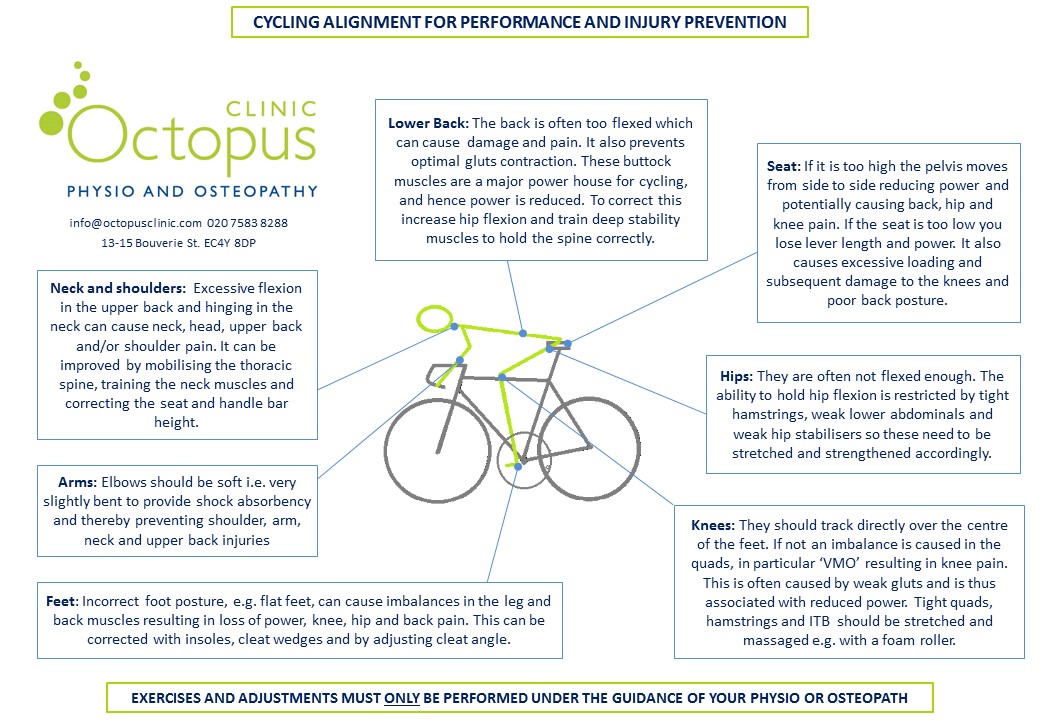Cycling
A huge number of our patients cycle either competitively or as a means of transport, we have Physiotherapists and Osteopaths that are specialists in cycling.
We provide cycling assessments so that, whether you are competing in the Etape or simply cycling to work, we know how to tweak body position and bike set up to enable recovery and improve performance.
If you have an injury you need to see an experienced Physiotherapist who will get you back on your bike ASAP.
Apart from those resulting from a fall, cycling injuries are normally as a result of:
- Incorrect body positioning or posture on the bike
- Inefficiencies in cycling technique
- Incorrect bike set up
- Weaknesses or imbalances in the muscles that enable good biking technique
- Stiffness in joints or soft tissues that prevent good bike technique
- A combination of the above
Common cycling injuries include the following.
- Pain at the front of the knee anterior knee pain which can be caused by:
- Pain at the side of the knee could be ITB friction syndrome.
- Pain in the neck or upper back could be caused by incorrect neck posture.
- Back pain, sometimes radiating into the legs could be a number of different conditions.
- Hip pain
Remember, it is important to have your pain fully assessed and treated by a Physiotherapist or Osteopath to prevent further damage occurring.
Please see below for tips on cycle set up and body positioning

-
Plantar Fascitis (pain sole of foot)
If the sole of your foot is tender to touch, particularly under the heel, and the pain came on gradually, you may have plantar fasciitis.It is often more painful first thing in the morning and can become very severe the longer you are on your feet. Plantar-fascitis is damage and...
Read More -
Neck Pain/Tightness
Mild neck pain and/or tightness that comes on slowly is commonly due to the upper back rounding forwards and the chin pointing forwards and upwards, which increases muscle and nerve tension and may cause pins and needles or pain in the arms and hands. Sometimes, breathing becomes restricted due to...
Read More -
Clicking ankles or feet
Clicking or crunching in the ankles or feet can be caused by a number of things. Most people fear that the clicking is caused by bone hitting bone. However, thankfully nowadays this is rare. If you have this, it is likely that for many years you have been suffering severe...
Read More -
Facet Joint Problems
Facet joint pain is normally localized: centrally over your spine or to one side. It may feel like a "catching pain" during certain movements like bending backwards, or turning. It is associated with poor posture, repetitive strain (e.g. horse riding) or injury (e.g. snowboarding falls)The common factors that contribute to...
Read More -
Patella Tendinopathy (pain front of knee below knee cap)
Please read how the knee works before reading the following. It can occur in any propulsive, impact based sports or as a result of a change in loading to the tendon. The patella (knee cap) tendon extends from the bottom of the knee cap and inserts into the tibial tuberosity...
Read More -
Hip Clicking
Clicking or crunching in the hip can be caused by a number of things. Most people fear that the clicking is caused by bone hitting bone. However, thankfully nowadays this is rare. If you have this, it is likely that for many years you have been suffering severe pain and...
Read More
Common Injuries
-
Glut/ VMO/ leg alignment exercise
Please click here to read 'how the knee works' before reading the following. This exercise trains the lateral glute muscle fibres, lower limb alignment, VMO (the inside part of the quads muscle) and stretches the calf so is a big hitter – if you can get it right! You will...
Read More -
ITB and TFL release
Please click here to read how the knee works before reading the following.
Read More -
How to find pelvic neutral
Please click here to learn how the back works before reading the following. Do not do the following if you have any back pain- you must see a Physiotherapist or Osteopath for a full assessment, diagnosis and guidance through the exercise. Please click on the link to learn how to...
Read More -
Breathing and relaxation training
Many spinal, hip and shoulder problems can be helped by retraining breathing habits and releasing the structures involved in breathing, such as the diaphragm and thoracic spine.
Read More -
Stretching
A note on static stretching v dynamic stretching I bet you can't remember the last time you saw elite athletes doing a static stretches pitch-, track- or court side pre-performance. That is because research now shows that static stretching is not advisable before exercise. This is because it slows...
Read More -
Shoulder exercises
There are a variety of exercises that are great for your shoulders including: 1) Train shoulder posture 2) Train your scapular stabilizers 3) Train serratus anterior muscle 4) Stretch the lats (latissimus dorsi) muscles 5) Train the rotator cuff muscles
Read More
Exercises
Related News
-
Physio kettlebell exercise video for back pain, strength and mobility
How to use kettlebells for back mobility and strength...
Read More -
‘I have back pain, what is causing it and what...
As a physiotherapist this is probably the most common question I get...
Read More -
Should you worry about your clicking joints? What is causing...
Our Physiotherapist gives you the answers you need in...
Read More -
Knee pain physio video: why your patella tendon is not...
If you have pain in the tendon at the front...
Read More